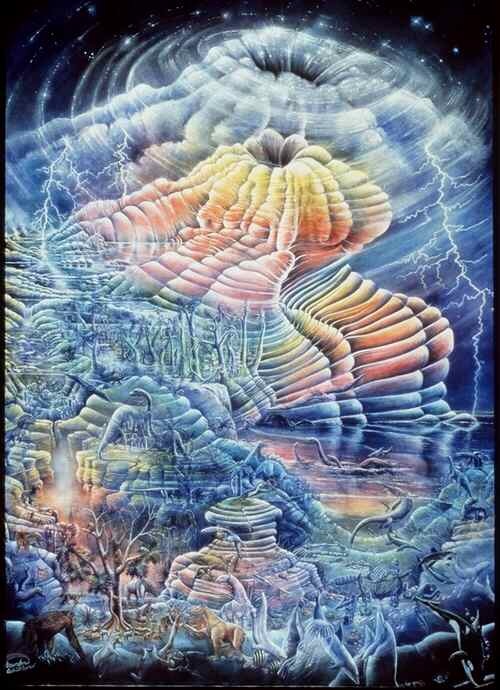
"Candle of Life"
An Oil on Canvas '1990'
![]()

"Candle of Life"
An Oil on Canvas '1990'
The energy from the solar disk of the newborn planet brings forth the urgency for life. Within the core of it's mass the "Candle of Life" burns.
Bursting forth during the four billion year period known as the pre-Cambrian era, life lay dormant in it's gestational state, waiting for the candle to ignite.
From the dawn of the Cambrian era through the Ordovician era to the end of the Silurian, some 195 million years later, the quickening of life on the planet remained in the primeval oceans and lakes. As the Silurian era drew to a close the drama of life shifted to the lands. The internal forces that continually reticulated the face of the earth, caused mountains to rise, and inland seas to recede, leaving behind rich layers of marine sediments, ending with Devonian era some 60 million years later.
The plants began to creep out into the sunlight, laying their green fingers upon the shores. The carboniferous forest emerged, carpeting the naked hills with ferns and leafy plants. The green mantling of the shores, caused marine life to migrate to the uninhabited lands. Descendants of sea scorpions, lungfish, and finally echthyostega, the first amphibian, carried a fish like tail but later developed feet in place of fins. This led the way for the late paleozoic procession of terrestial life. The reptiles and the early ancestors of the mammals were in their beginnings. This spanned approximately 125 million years.
The Mesozoic curtain opened on the age of reptiles. The first dinosaurs appeared in the Triassic era 49 million years ago. The Jurassic epoch of 46 million years, brought about the sauropods, long necked, long tailed, four legged monsters, which included Dipladocus, the largest land animal. Stegosaurs, armored reptiles, weighed up to 10 tons. They ate from the then abundant flora of true conifers, cycads and cycadeoids that grew on the hillsides and plains. These beast fell prey to the great carnivorous theropods. Flying reptiles glided through the air. These including a sparrow sized species and others up to four feet long, with slender club like tails. In the procession were the carnivorous masters of the oceans like ichthyosaurs and plesioaurs. The cretaceous epoch of some 72 million years ushered in the following plants, angiosperms. Dinosaurs dominated the land and seas. Pteranodon, a toothless, hammer headed flying reptile with a wingspan of 25 feet soured in the air. Crouched in the rock sand decaying tree trunks below, hid rat-sized marsupials and insectivores, forerunners of the shrews.
The Cenozoic period introduced the age of mammals. New species included two main groups: hoofed mammals and carnivores. The Paleocene and Eocene epochs held new arrivals, such as early horses (the three-toed, collie-sized mesohippus), the saber-toothed cats, diatryma (a seven foot high carnivorous bird), and Mesonyx, the fore-runner of the canine groups. In the Oligocene and Miocene epochs many familiar species of
modern animals emerged. Early ancestors of the deer, pigs, weasels, raccoons, bears and primates developed. This included proconsul, a primate that was a prelude to Homo sapient. Whales and other marine mammals replaced the giant reptiles that had once dominated the seas. During the 62 million years of the terriary epoch the earth would team with life, more diverse than ever would thrive again, after the coming of man.
I now have prints of this painting "Candle Of Life" in Giclee format available for purchase. Each Print comes with a signed printed copy of it's "Legend". Print Size: 13 inches by 17 inches. Priced at $60.00 plus $19.95 for Fedex shipping, art carton, insurance and handeling. Item #101990. Page 3. "Rainbow" will sign the print any way you want it. Just include the name of the print, the item number, the date of purchase and a note of how you want it signed, in an Email.
Home Page Info Page Main Gallery Specials Page Contact Us